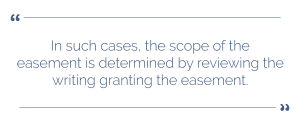Updated on November 28, 2023
What are the most common types of easements used for properties? Let’s discuss which of the different types of easements are used the most.
Key Takeaways
- Easements are limited rights that allow a person to use another person’s property or restrict the owner’s use in some way.
- The two most common types of property easements are express easements and prescriptive easements.
- Express easements are conveyed through a written deed and clearly define the scope of the easement.
- On the other hand, prescriptive easements are granted through court actions and are less common as they require specific conditions to be met over time.
- Prescriptive easements are established through open, notorious, continuous, and adverse use of the property for five years.
- If you are facing an easement dispute, it’s essential to seek the advice of an experienced easement dispute attorney.
Most Common Type of Easement
An easement is an interest in the property belonging to another that allows the owner of the easement to have a limited right to use another property or to prevent the property owner’s use of his or her property in some limited way. In short, an easement imposes a burden on another property owner and is an encumbrance on real property.
The two most common types of property easements are an express easement and a prescriptive easement. Out of the two types of easements, an express easement is the most common type of easement.

Most Used Easement: Express Easement
An express easement is typically conveyed via deed or other writing, which governs the terms of the easement. (Scruby v. Vintage Grapevine, Inc. (1995) 37 Cal.App.4th 697, 703 [43 Cal.Rptr.2d 810], as modified on denial of reh’g (Sept. 6, 1995) [“Scruby emphasizes the grant gives them ‘[a] nonexclusive easement, 52 feet in width, for road and utility purposes.’”].)
In such cases, the scope of the easement is determined by reviewing the writing granting the easement. (Id. at 702 [“In construing an instrument conveying an easement, the rules applicable to the construction of deeds generally apply. If the language is clear and explicit in the conveyance, there is no occasion for the use of parol evidence to show the nature and extent of the rights acquired.”].)
Prescriptive Types of Easements
In contrast, a prescriptive easement is less common because a prescriptive easement is granted through the courts as a result of one landowner acquiring rights to use another property in a specific way in an adversarial manner. (Mesnick v. Caton (1986) 183 Cal.App.3d 1248, 1261 [228 Cal.Rptr. 779] [“By contrast, the successful claimant of a prescriptive easement gains not title, but the right to make a specific use of someone else’s property.”].)
Thus, “[a] party claiming establishment of a prescriptive easement must show (1) use of property which has been (2) open and notorious, (3) continuous, and (4) adverse for five years.” (Id. at 1260.) As prescriptive easement are established “involuntarily”, it is no surprise they are less common.
Our Los Angeles Easement Dispute Attorneys have dealt with various types of easement disputes. If you are doing through a potential easement dispute and need representation, please get in touch to schedule a case evaluation consultation. You can call us directly at (310) 954-1877, text us at (310) 706-2265, or send us a message here. We have experience drafting easements and resolving disputes involving easements.
